
Shining a light on the massive global surge in merger control filings
The data White & Case gathered from 58 of the most active merger control jurisdictions globally reveals trends and insights that can't be gleaned from data on single jurisdictions considered in isolation.
10 min read
More from WAMS
White & Case Global Antitrust Merger StatPak
White & Case Antitrust/Competition is a “one-stop shop for global deals.”
The Legal 500 US 2021
About the WAMS dataset
White & Case collects and analyzes data from a variety of sources for WAMS. This includes communicating directly with competition authorities to capture the latest data available, as well as analyzing public reports issued by competition authorities and others sources such as the Organisation for Economic Co-operation and Development (OECD). WAMS will be updated and expanded on a regular basis.
For a number of jurisdictions, 2021 data has not yet been published by the antitrust agency at the time of this release.
While data is available for certain jurisdictions over a number of years, there are gaps in reporting for certain jurisdictions. Where applicable, we offer clarifications regarding the data.
Note: This is an update to the initial survey originally published on December 27, 2021. It incorporates newly available data from the United States, EU, and several other jurisdictions.
We are pleased to introduce the White & Case Global Antitrust Merger StatPak (WAMS), a resource providing information on merger control filing activity by competition authorities around the world. The WAMS survey currently includes filing data from 58 of the most active merger control jurisdictions in the world.
WAMS is the first tool of its kind to serve as a real-time clearinghouse for global merger notification data—all in one place—in an easy-to-access format. No single compilation of merger control filings has previously been assembled, particularly with anything like real-time, calendar-year statistics.
White & Case will continue to gather this data, adding countries when information becomes available and refreshing the dataset on a regular, ongoing basis.
As of 2019, 135 jurisdictions have enacted merger control laws that mandate competition authorities to review certain transactions, which is a significant increase compared to the number of regimes that existed ten years ago.1 As a result, the number of merger control filings have increased at an accelerating rate over the past half-century, particularly in the 2000s.
With the changing market realities and the rising tide of competition enforcement around the globe, this up-to-date merger data will be particularly important for companies considering mergers and acquisitions.
The WAMS data also show the rise of new antitrust merger enforcement regimes onto the scene, with implications for merging parties.
Table 1 below shows the results of our first compilation of worldwide merger notification data from 58 of the largest, most active competition authorities. The data are compiled by calendar year to the extent possible, although many agencies report annual figures on fiscal years that vary considerably.
Data for 2016 through 2020 in these jurisdictions show that globally, we routinely now see approximately 13,000 merger control filings per year in the most active 58 antitrust jurisdictions currently featured in WAMS. In these jurisdictions, there were nearly 83,600 cumulative filings from 2016 through 2021, with the data for 2021 still coming in.
Charts 1 and 2 below illustrate the regional distribution of global merger notifications in 2020 and 2019. In 2020, 40.2 percent of global merger control notifications accounted for by WAMS were filed in Europe; 29.5 percent were filed in the Asia-Pacific region; and 17.4 percent, 7.6 percent, and 5.2 percent were filed in North America, the Middle East and Africa, and South America, respectively.
A similar pattern occurred in 2019: 43.9 percent of global merger control notifications accounted for by WAMS were filed in Europe; 25.8 percent were filed in the Asia-Pacific region; and 17.8 percent, 7.1 percent, and 5.4 percent were filed in North America, the Middle East and Africa, and South America, respectively.
Global filing trends for 2021
Based on the WAMS survey data, merger control filings with antitrust agencies overall rose significantly in 2021 over the levels of previous years.
Chart 3 shows merger control filings for 2021 compared to the five-year average of 2016 through 2020 in the 25 jurisdictions that provide enough of a level of reporting transparency permitting White & Case to calculate calendar year 2021 merger notification activity.
Judging by the 25 jurisdictions with 2021 data compiled in the WAMS survey, worldwide merger notifications are estimated to have increased nearly 42 percent in 2021 over the five-year average of 2016 through 2020.
In 2021, there have been 8,195 notified mergers in the 25 jurisdictions as compared to 5,782, the year-over-year average between 2016 and 2020. There were some notable regional and national trends in merger control filings in calendar year 2021 as follows.
United States: Merger control filings surged in 2021
According to WAMS survey data, the United States experienced a tremendous rise in merger control filings in calendar year 2021. Reported US merger transactions are 110 percent higher in calendar year 2021 than in 2020.
Of course, the COVID-19 pandemic affected calendar year 2020 merger control filings, as demonstrated by the dip in reported transactions in the months of April and May of 2020 in chart 4. But a comparison of calendar year 2021 reported US merger transactions against the pre-COVID 2019 calendar year reported transactions reveals a similar dramatic increase of nearly 108 percent for 2021 over pre-pandemic 2019 levels, as shown in chart 4A
The tremendous jump in reported US merger transactions in calendar year 2021 is also in contrast to the five-year average for the US antitrust agencies in 2016 through 2020—an increase of nearly 107 percent in 2021 in the US over the five-year average.
November typically represents a busy month for US HSR (Hart-Scott-Rodino) filing activity. However, November 2021 represented the all-time high for HSR filings in the US in the modern era, with 607 reported merger transactions to the antitrust agencies, more than a 40 percent year-over-year increase of the November 2020 total of 424 reported merger transactions. (In December 2000, the US Hart-Scott-Rodino Act was amended to raise the merger filing thresholds.) This increase in November 2021 may be the result, in part, of the 2021 policy suspending Early Termination (the clearance of certain mergers faster than 30 days), as discussed below.
With December 2021 data now in, December 2021 also represented a significant increase in filings, dwarfing the number of filings made in any previous December since 2011.
In the 20-year period 2001 to 2021, calendar year 2021 represents a 20-year high in reported US merger transactions. In calendar year 2021, reported mergers in the US have more than doubled over the average annual level of the past 20 years. Merger filings in 2021 in the US were up 155 percent over the 20-year average level.
US merger policy in 2021
The FTC announced early in 2021 that it would temporarily suspend the decades-long practice of granting early termination of the HSR waiting period for the vast majority of transactions that do not raise substantive antitrust concerns.2 The suspension has continued throughout the remainder of the 2021 calendar year. As a result, merging parties in the US for most mergers with a 30-day waiting period had to wait the entire 30 days before closing.
In August 2021, the FTC announced that it would send a pre-consummation warning letter to certain merging parties when the FTC is not able to sufficiently investigate a merger transaction within the HSR waiting period.3 Although expiration of the HSR waiting period never provides permanent approval from the FTC or the US Department of Justice (DOJ), merging parties could traditionally have a reasonable amount of assurance that if the HSR waiting period expired, there would not be a continuing investigation or significant risk of an impending merger challenge.
Germany: Filings decrease following regulatory changes
Germany changed its merger filing thresholds in early 2021. While it has been unclear how the change in German merger control filing thresholds would affect the number of notifications submitted throughout the year, the WAMS survey demonstrates that the number of filings in Germany appears to have dropped less than anticipated (chart 7).
Based on the WAMS survey results for 2021, it appears that notifications in Germany are down roughly 16 percent versus 2020 and are down closer to 21 percent versus the five-year average of 2015–2019, as shown in chart 8 below.
United Kingdom: No Brexit increase in merger filings yet
Following the end of the Brexit transition period on December 31, 2020, UK authorities had anticipated that its merger workload would increase perhaps by as much as 40 percent and 50 percent as a number of cases notified to the European Commission would also be notified in the UK. Certainly Brexit has impacted the considerations merging parties evaluate.4 According to WAMS survey data, UK merger notifications have so far not increased post-Brexit in calendar year 2021.
As of November 30, 2021, there have been 33 notified mergers in the UK according to WAMS data. This level of merger notification is largely the same as the total figures for 2020 (38) but significantly below the average of 60.4 filings for the five-year period of 2015 through 2019 in the UK.
Middle East and North Africa: Dramatic growth in merger notifications
One of the clear trends of the past four years according to the WAMS survey has been a steady increase in filings for merger control in the Middle East and North Africa in 2017 through 2020. The merger control regimes have become more mature, and it appears as well that economic activity is rising throughout the Middle East and North Africa region. We expect this trend to continue based on WAMS data and our experience.
Over the past five years (2017–2021), WAMS StatPak data demonstrate that merger control filings within the Middle East and North Africa region have increased dramatically as merger notifications regimes have come into existence. Merger filings in the Middle East and North Africa have nearly doubled in the past four years (2017–2020), according to the WAMS survey. For example, in November 2018, the Moroccan Competition Council was reactivated, resulting in reported merger control filings in 2019 and thereafter.
Saudi Arabia had only two notified mergers in 2013. By calendar year 2020, Saudi Arabia in 2020 received 137 merger notifications (an increase of more than 350 percent versus the seven-year 2013–2019 average).5
Brazil: Significant increase in merger notifications in 2021
The WAMS survey also shows a significant increase in merger control filings in Brazil in calendar year 2021. The WAMS data show a 54 percent increase in 2021 merger filings in Brazil, as compared to the average in the preceding five years (2016-2020).
European Union: 2021 was a historic year for European Commission merger filings
In Europe, 2021 represented the second-highest number of merger notifications for the European Commission (EC) since 1990. The EC accepted 405 merger filings in 2021, a 12 percent increase compared to 2020.
WAMS: A continuing effort
The White & Case Antitrust Merger StatPak (WAMS) is a practical survey tool that will be refreshed regularly. It will help companies and practitioners assess the merger notification landscape to see trends and filing activity around the globe.
It is hoped that the WAMS will prompt greater transparency and additional real-time reporting by antitrust merger control authorities around the world. Transparency assists merging parties in complying with the law.
1 OECD (2021), OECD Competition Trends 2021, Volume II, Global Merger Control.
2 Grants of Early Termination of HSR Waiting Period Temporarily Suspended By DOJ And FTC – Merging Parties Should Expect to Wait the Full 30 Days Until Further Announcement, White & Case LLP, Feb. 2, 2021.
3 Federal Trade Commission's Pre-Consummation Warning Letters Signal New Risk of Closing After Hart-Scott-Rodino Act Waiting Period Expiration, White & Case LLP, Aug. 5, 2021.
4 The impact of Brexit on merger control rules, White & Case LLP, July 17, 2018.
5 Key Developments in Saudi Arabia Merger Control: First Rejection, Review Guidelines, and New Tools, White & Case LLP, Dec. 20, 2021.
The WAMS team is comprised of White & Case's global network of antitrust professionals, with particular contributions from J. Mark Gidley, Katarzyna Czapracka, Marc Israel, Jérémie Jourdan, Jérémie Marthan, George L. Paul, Tamer Nagy, Michal Palisin, Martino Sforza, Thilo-Maximilian Wienke, Takako Onoki, Fanny Abouzeid, Reem Albakr, Gabriela Baca, Laura Del Olmo, Carlotta Frascoli, Marika Harjula, Joao Lacerda, Germán Ricardo Macías, Daniel J. Rosenthal, Iakovos Sarmas, Anna Stárková, Ksenia Tyunik, Allaa Mageid, Nathan Martin, Esther Gabilondo, and Peter Citron.
White & Case means the international legal practice comprising White & Case LLP, a New York State registered limited liability partnership, White & Case LLP, a limited liability partnership incorporated under English law and all other affiliated partnerships, companies and entities.
This article is prepared for the general information of interested persons. It is not, and does not attempt to be, comprehensive in nature. Due to the general nature of its content, it should not be regarded as legal advice.
© 2022 White & Case LLP

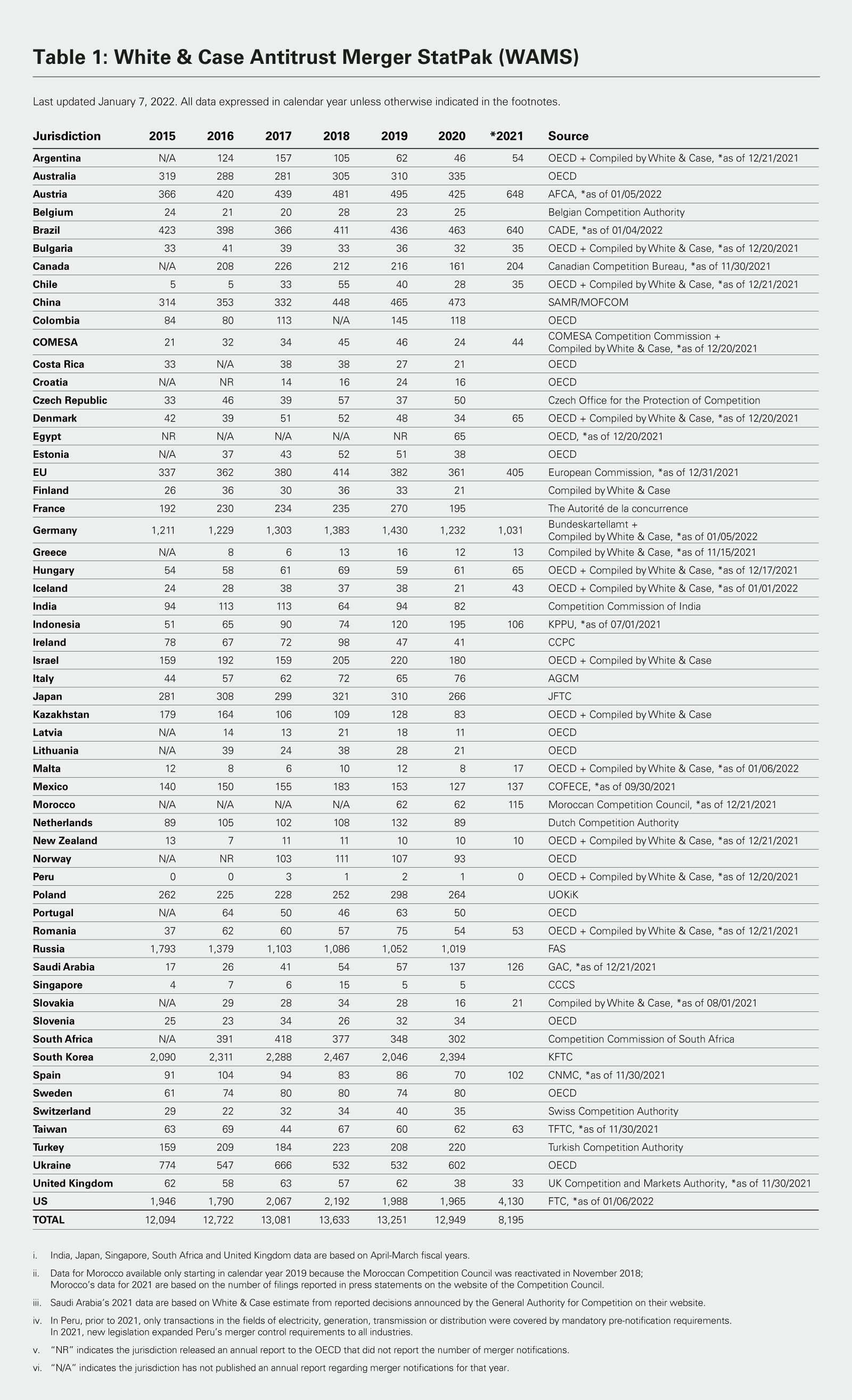 View full image: White & Case Antitrust Merger StatPak (WAMS)
View full image: White & Case Antitrust Merger StatPak (WAMS)
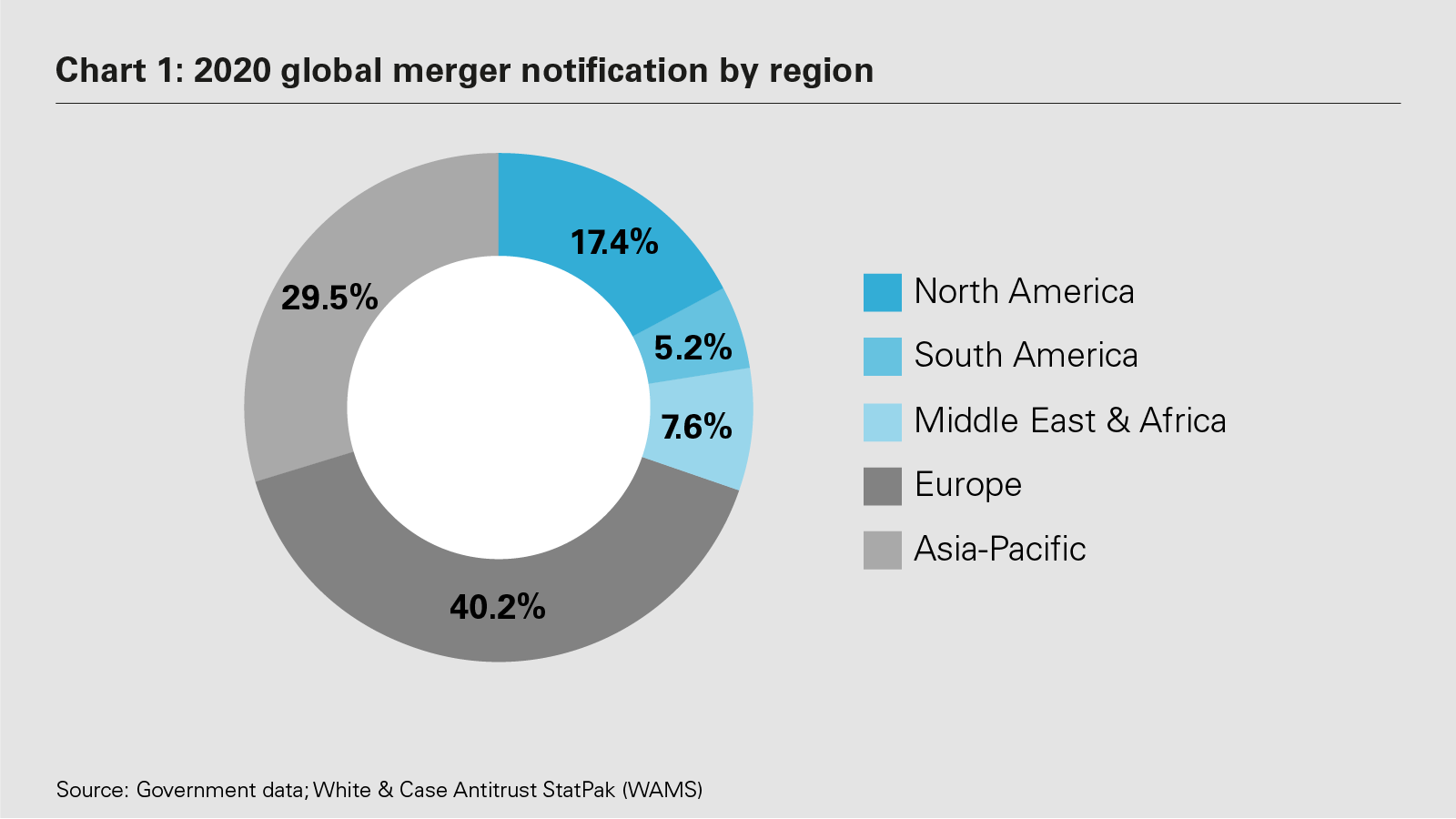 View full image: 2020 global merger notification by region (PDF)
View full image: 2020 global merger notification by region (PDF)
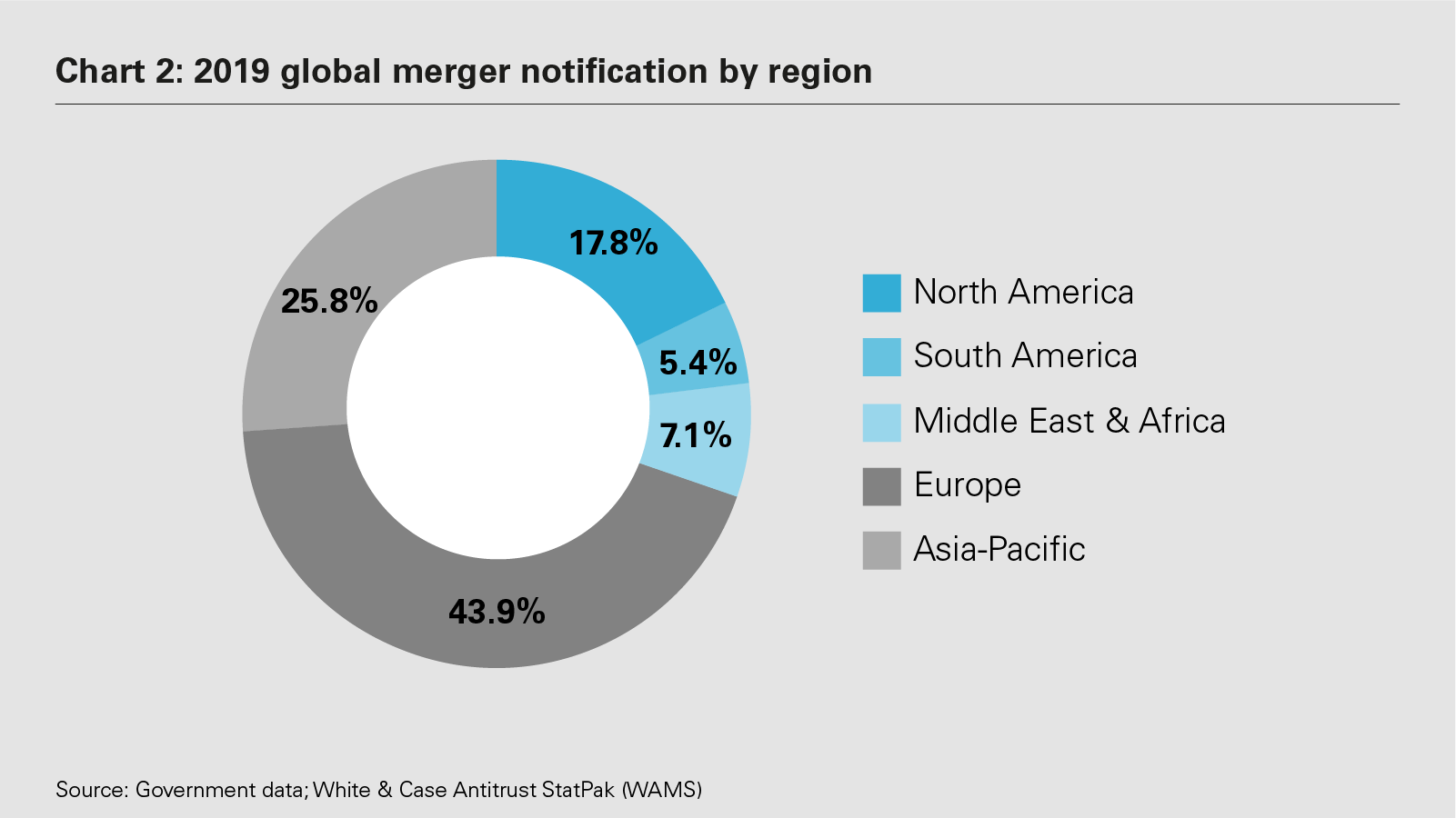 View full image: 2019 global merger notification by region (PDF)
View full image: 2019 global merger notification by region (PDF)
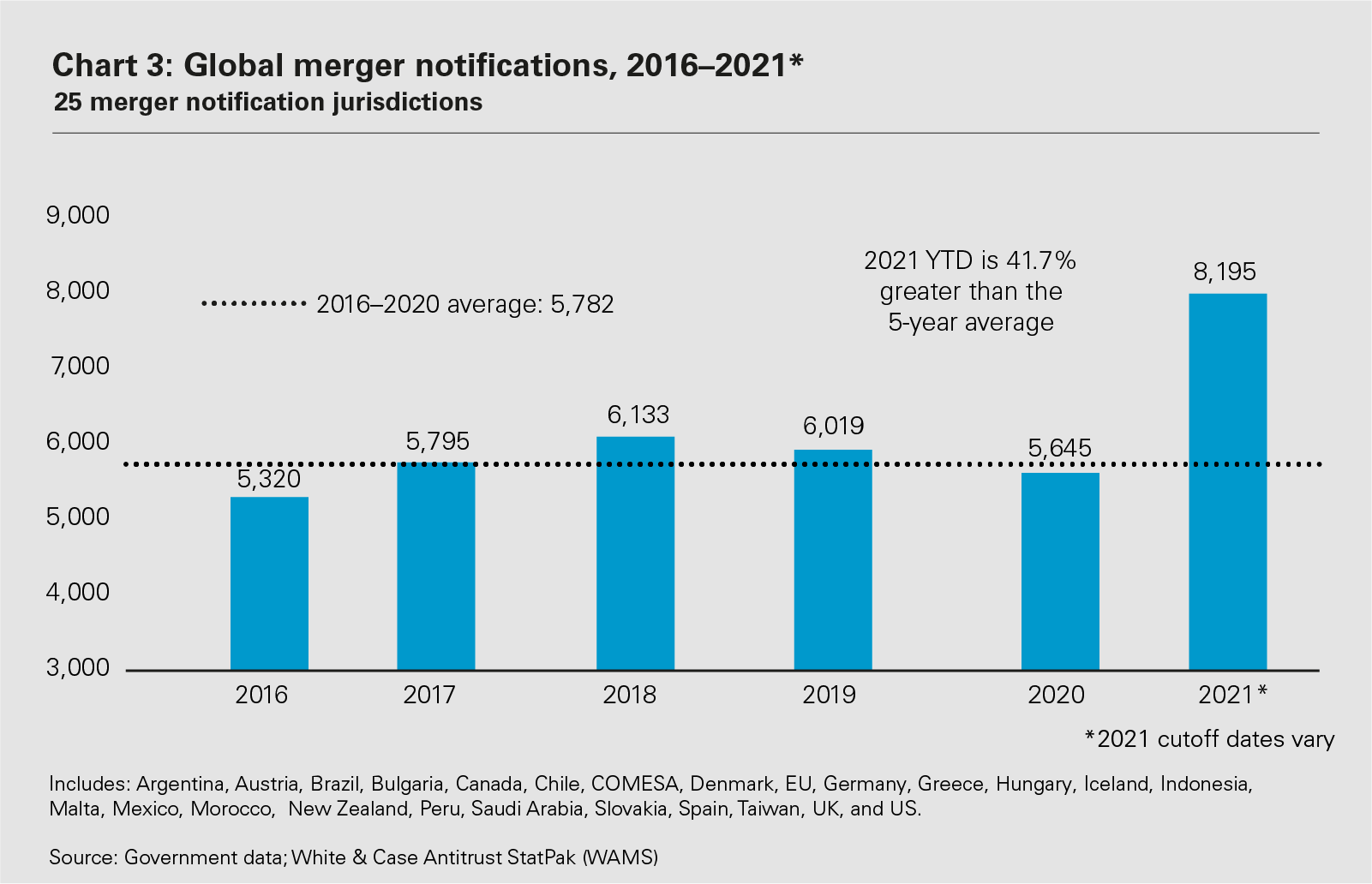 View full image: Global merger notifications, 2016–2021 (PDF)
View full image: Global merger notifications, 2016–2021 (PDF)
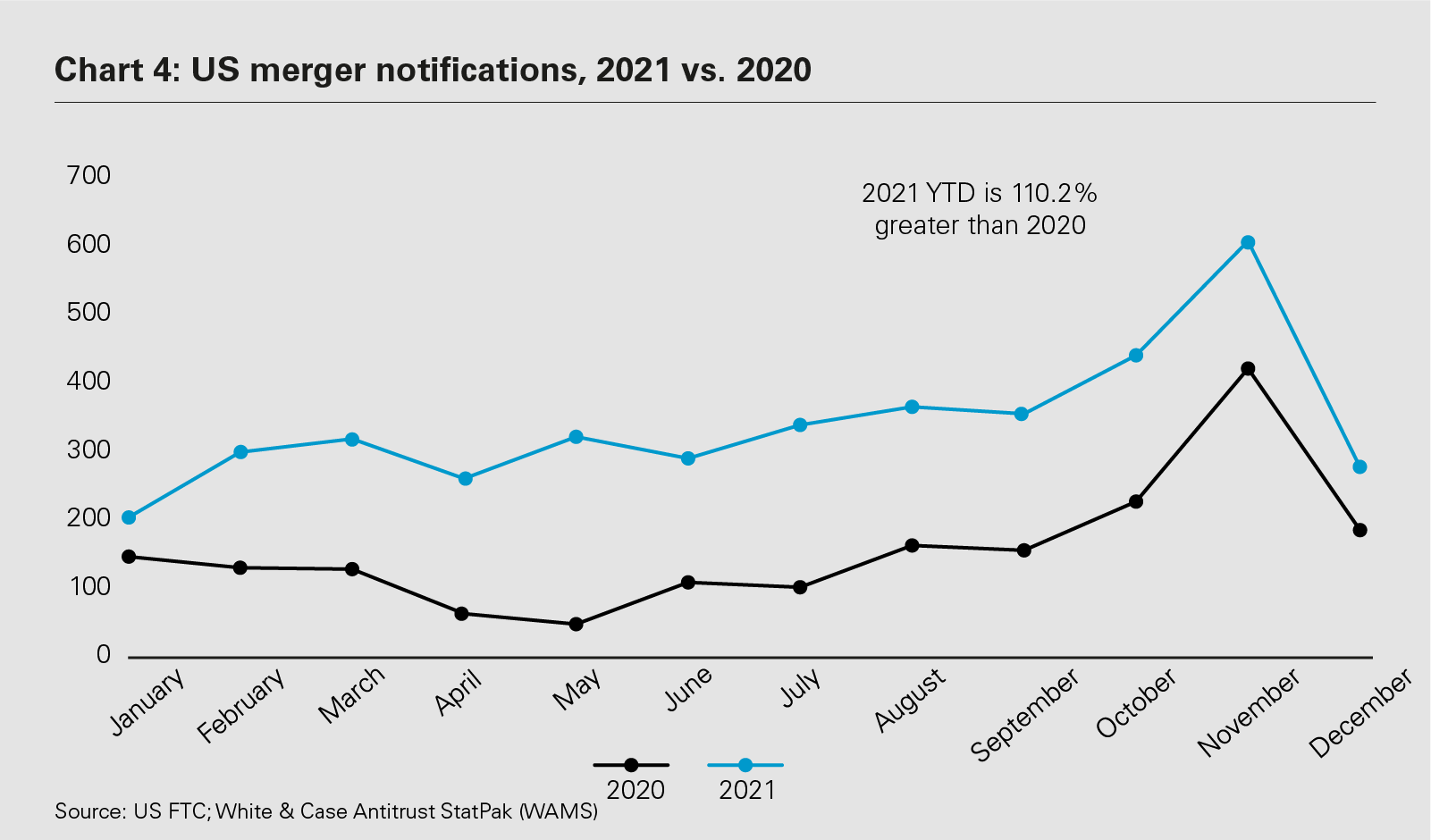 View full image: US merger notifications, 2021 vs. 2020
View full image: US merger notifications, 2021 vs. 2020
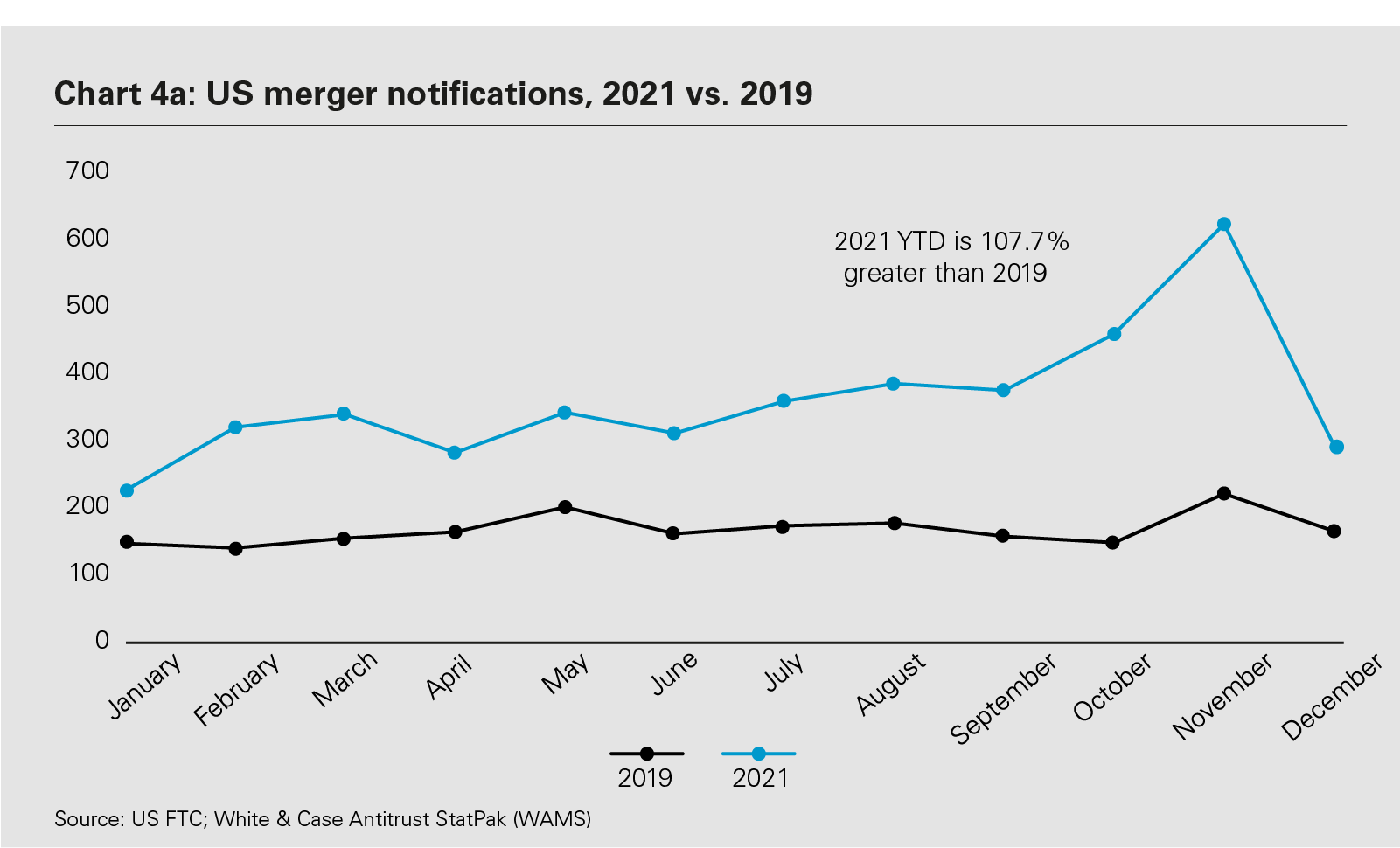 View full image: Chart 4a: US merger notifications, 2021 vs. 2019 (PDF)
View full image: Chart 4a: US merger notifications, 2021 vs. 2019 (PDF)
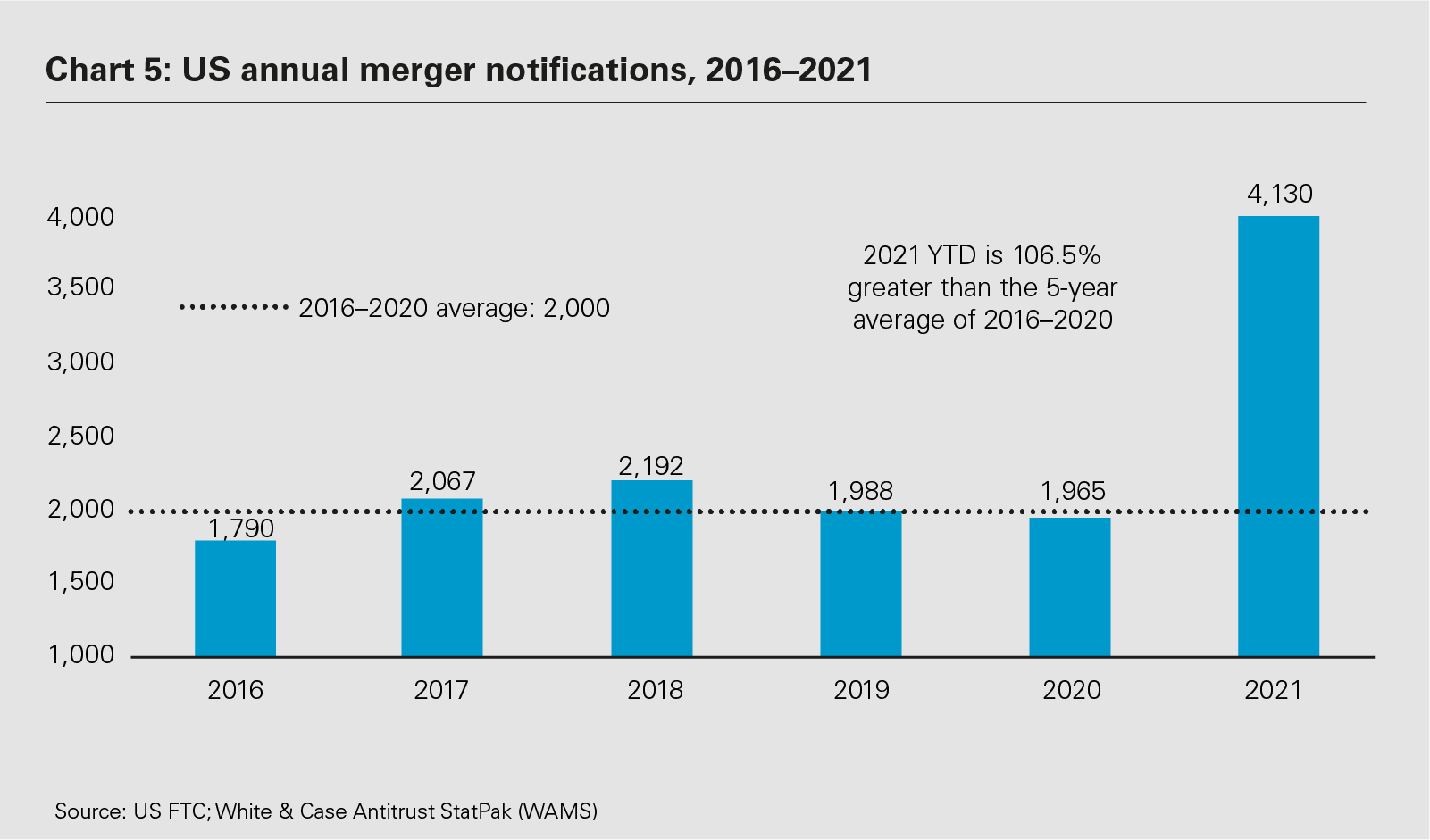 View full image: US annual merger notifications, 2016–2021 (PDF)
View full image: US annual merger notifications, 2016–2021 (PDF)
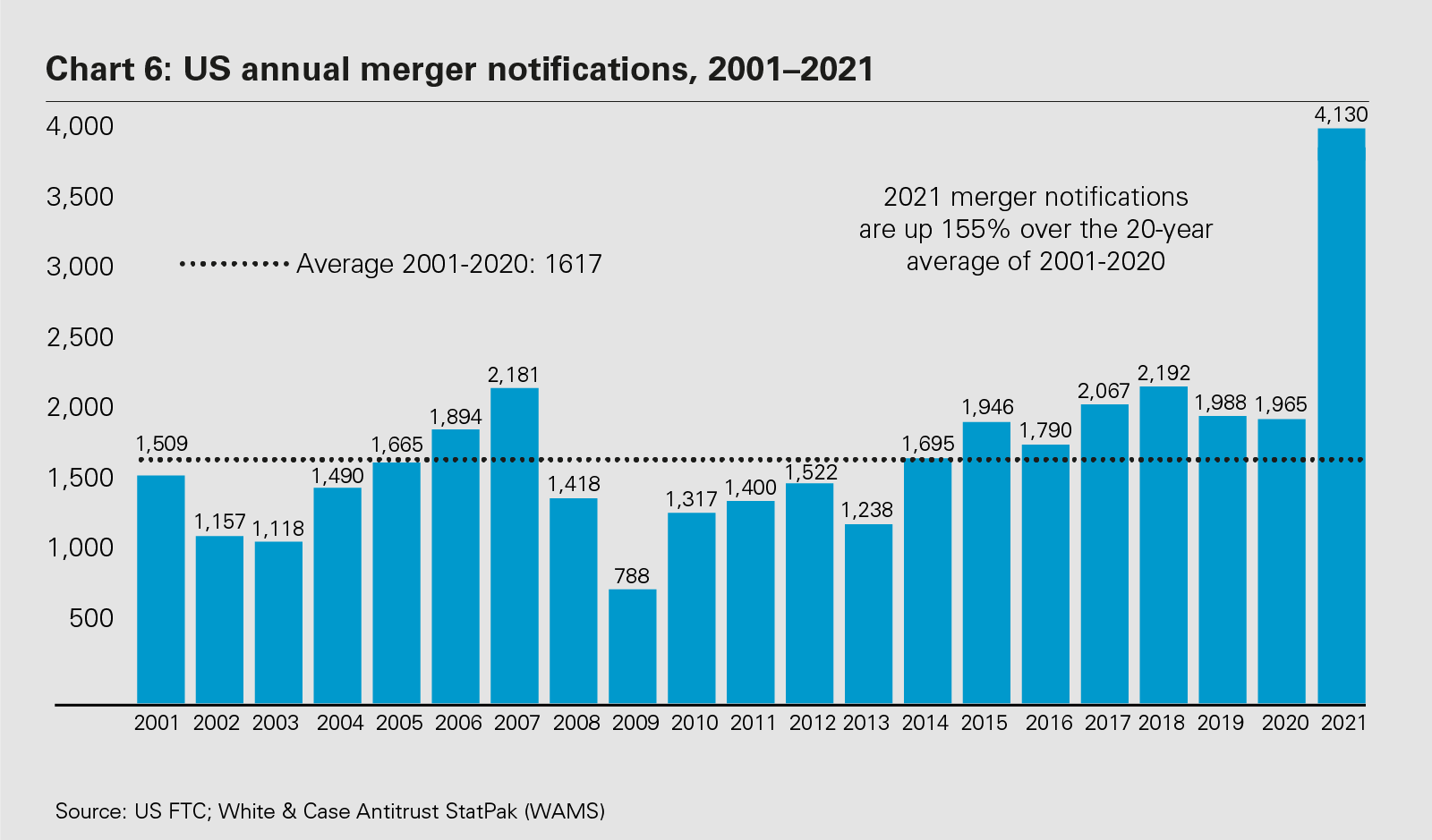 View full image: US annual merger notifications, 2001–2021 (PDF)
View full image: US annual merger notifications, 2001–2021 (PDF)
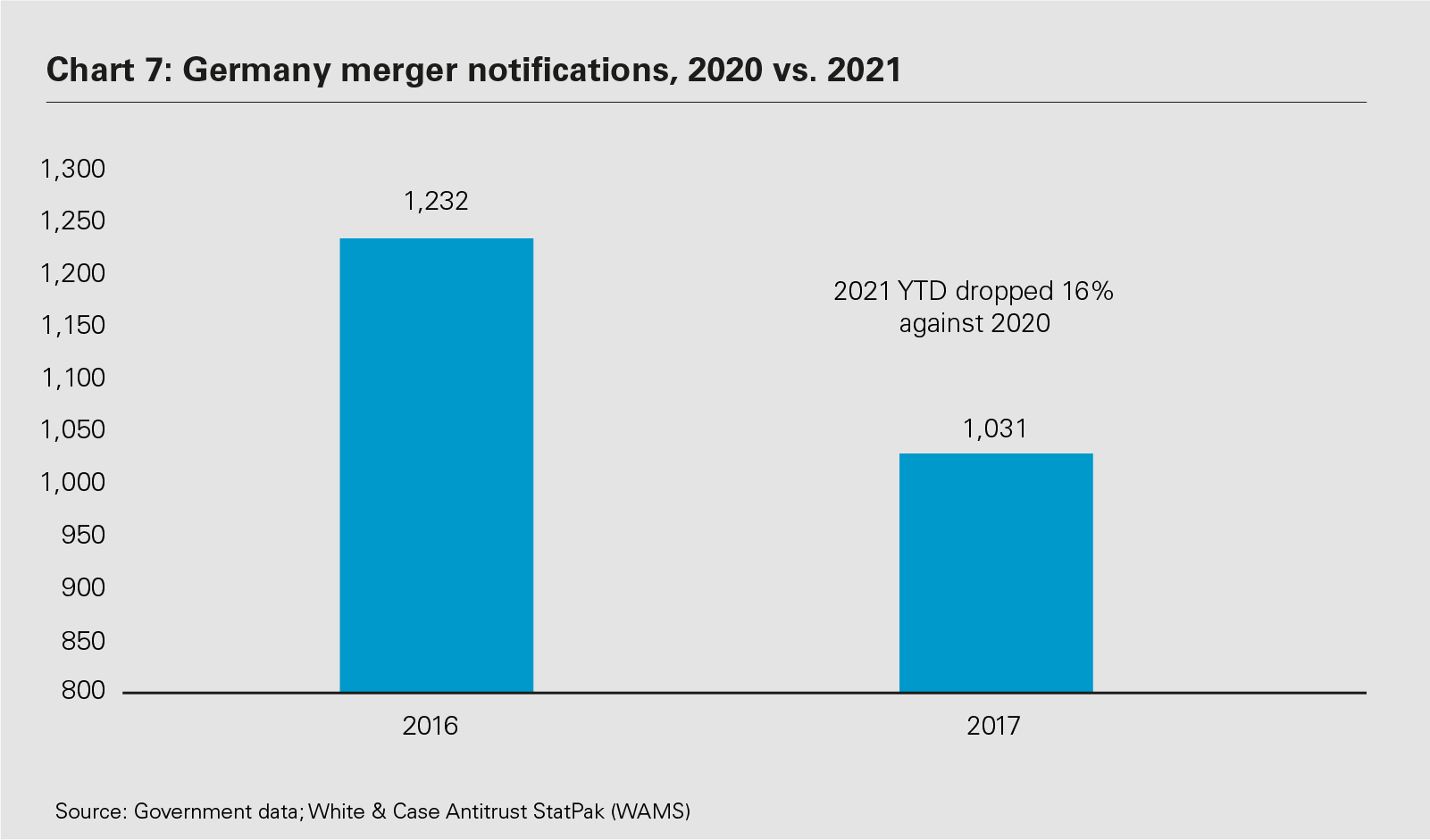 View full image: Germany merger notifications, 2020 vs. 2021
View full image: Germany merger notifications, 2020 vs. 2021
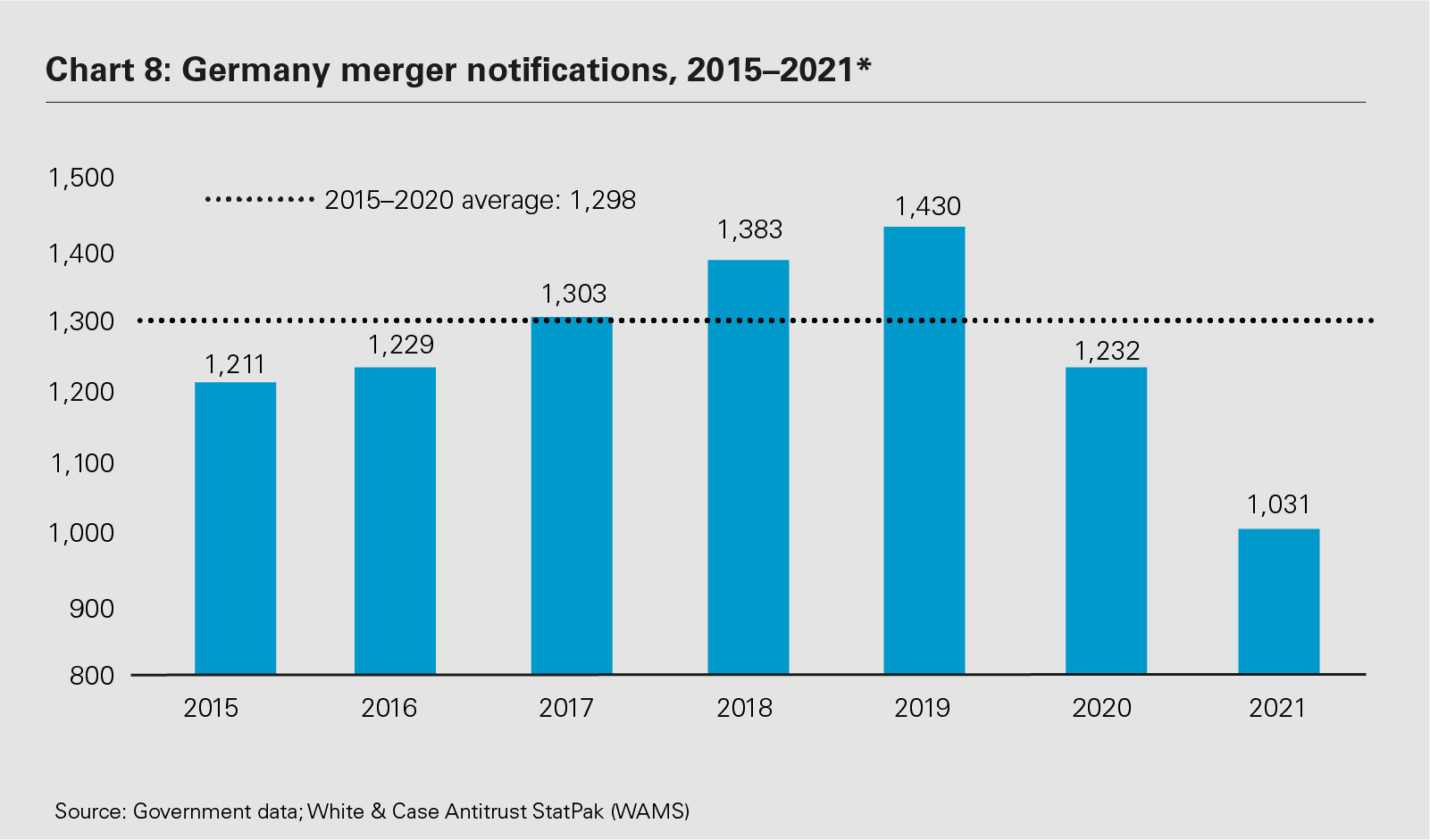 View full image: Germany merger notifications, 2015–2021* (PDF)
View full image: Germany merger notifications, 2015–2021* (PDF)
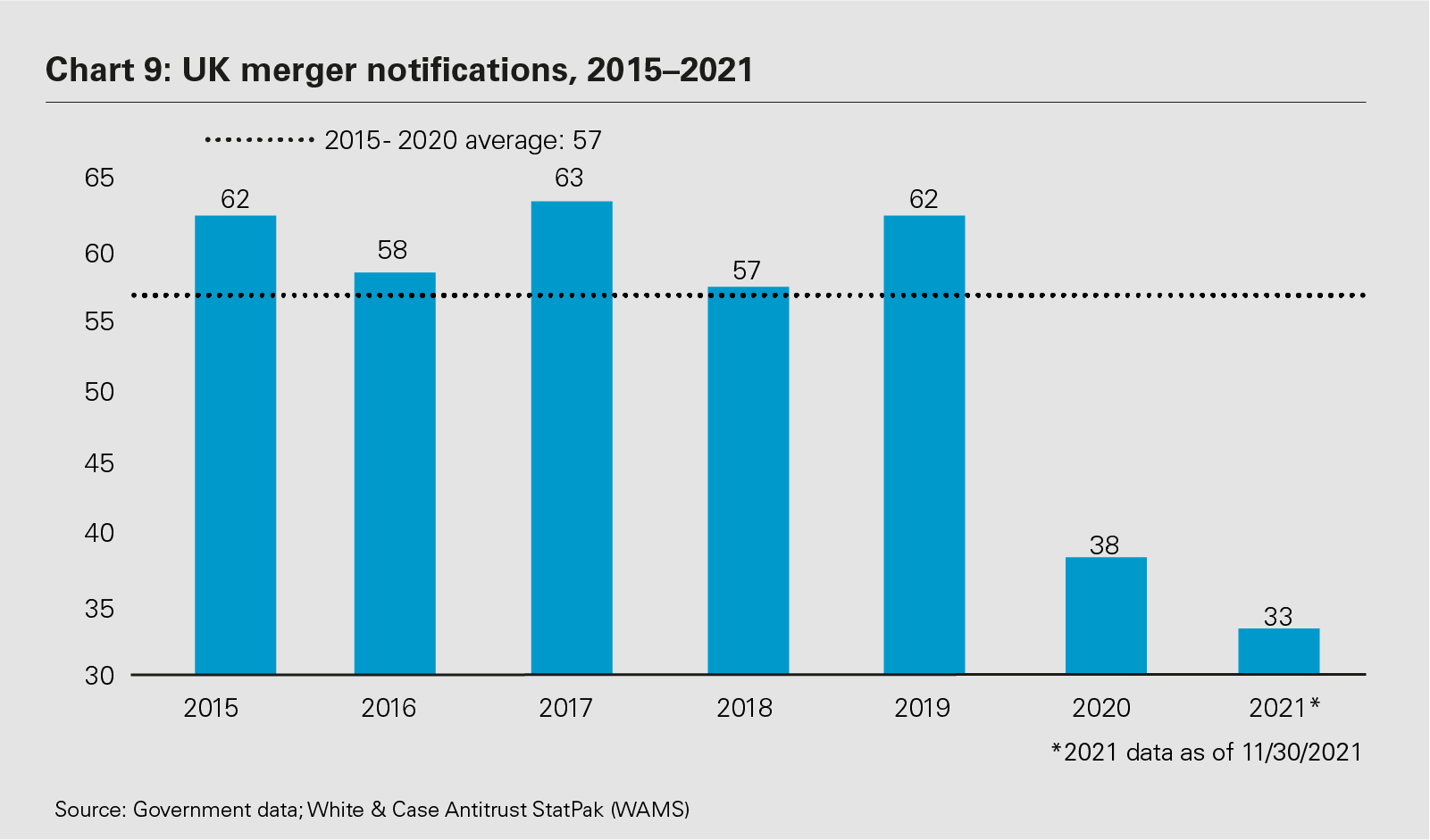 View full image: UK merger notifications, 2015–2021 (PDF)
View full image: UK merger notifications, 2015–2021 (PDF)
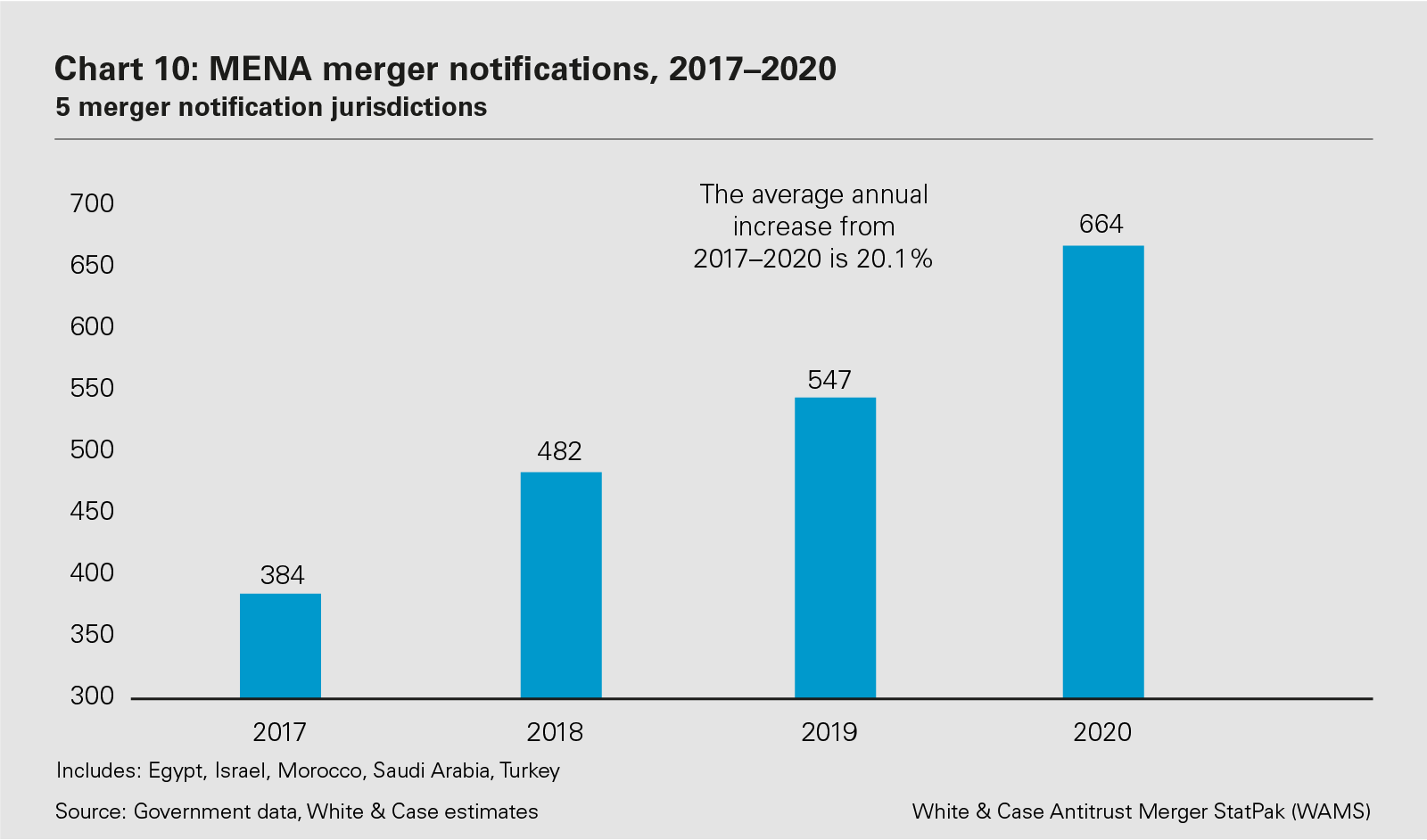 View full image: MENA merger notifications, 2017–2020 (PDF)
View full image: MENA merger notifications, 2017–2020 (PDF)
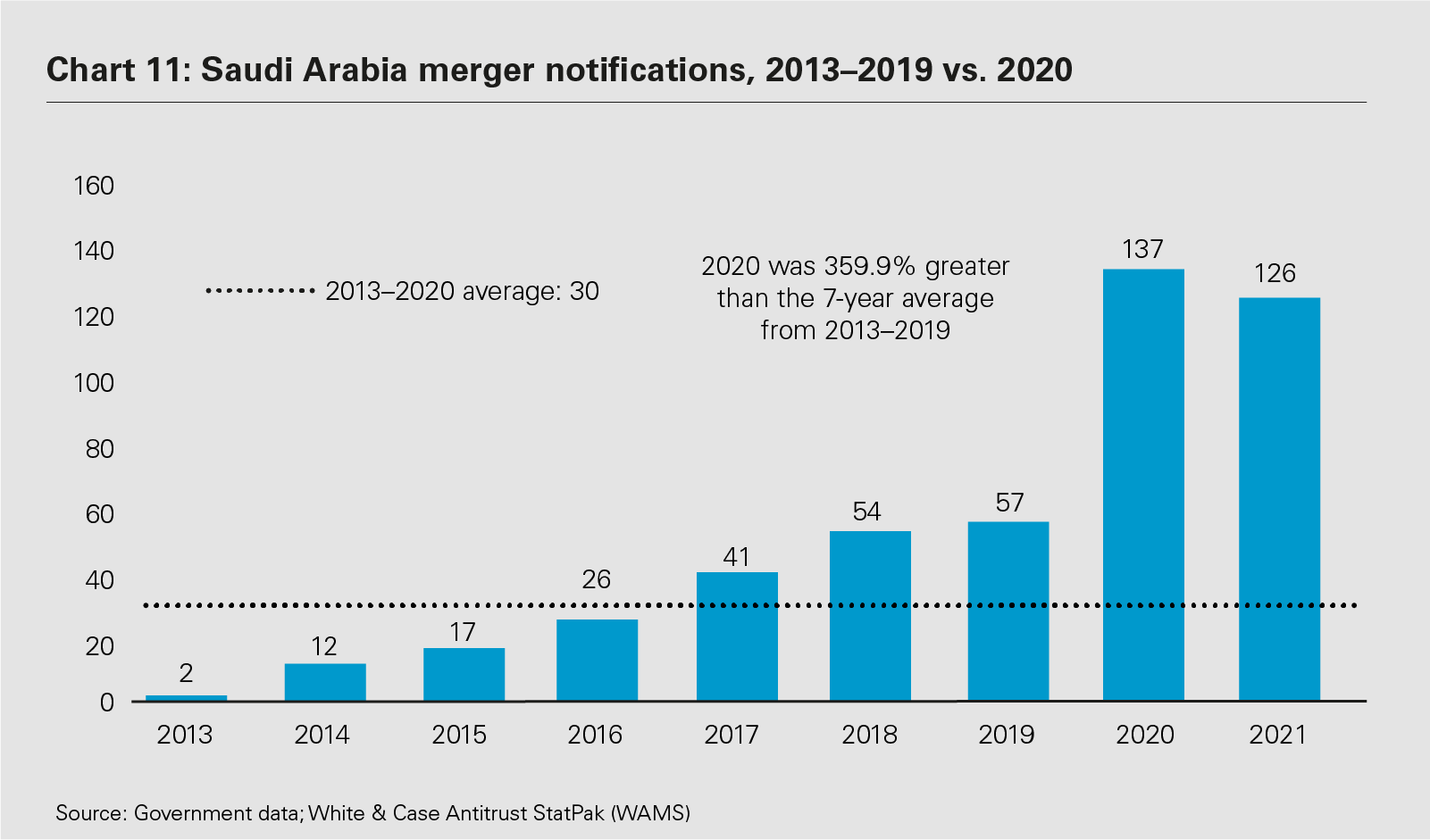 View full image: Saudi Arabia merger notifications, 2013–2019 vs. 2020 (PDF)
View full image: Saudi Arabia merger notifications, 2013–2019 vs. 2020 (PDF)
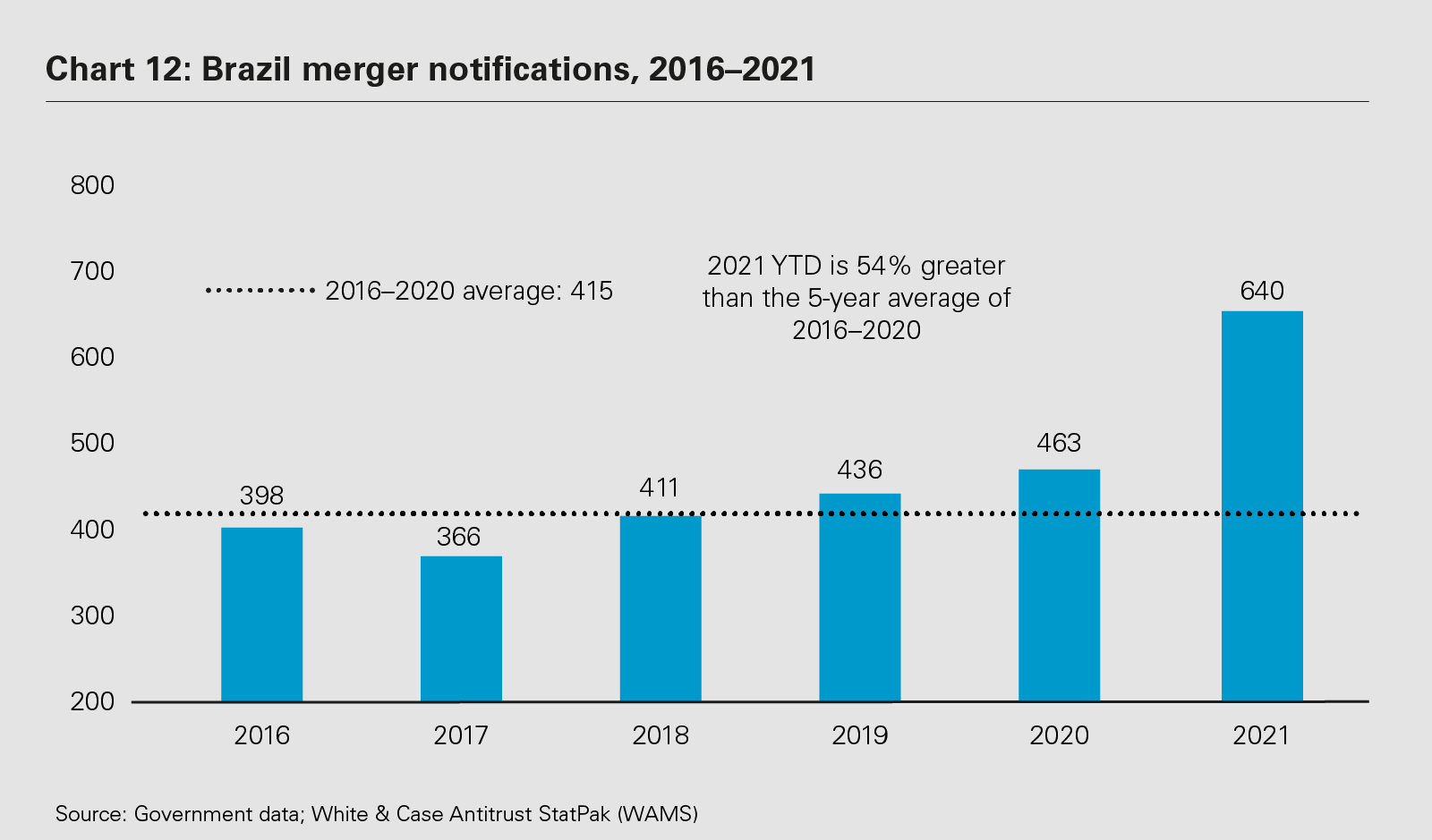 View full image: Brazil merger notifications, 2016–2021 (PDF)
View full image: Brazil merger notifications, 2016–2021 (PDF)
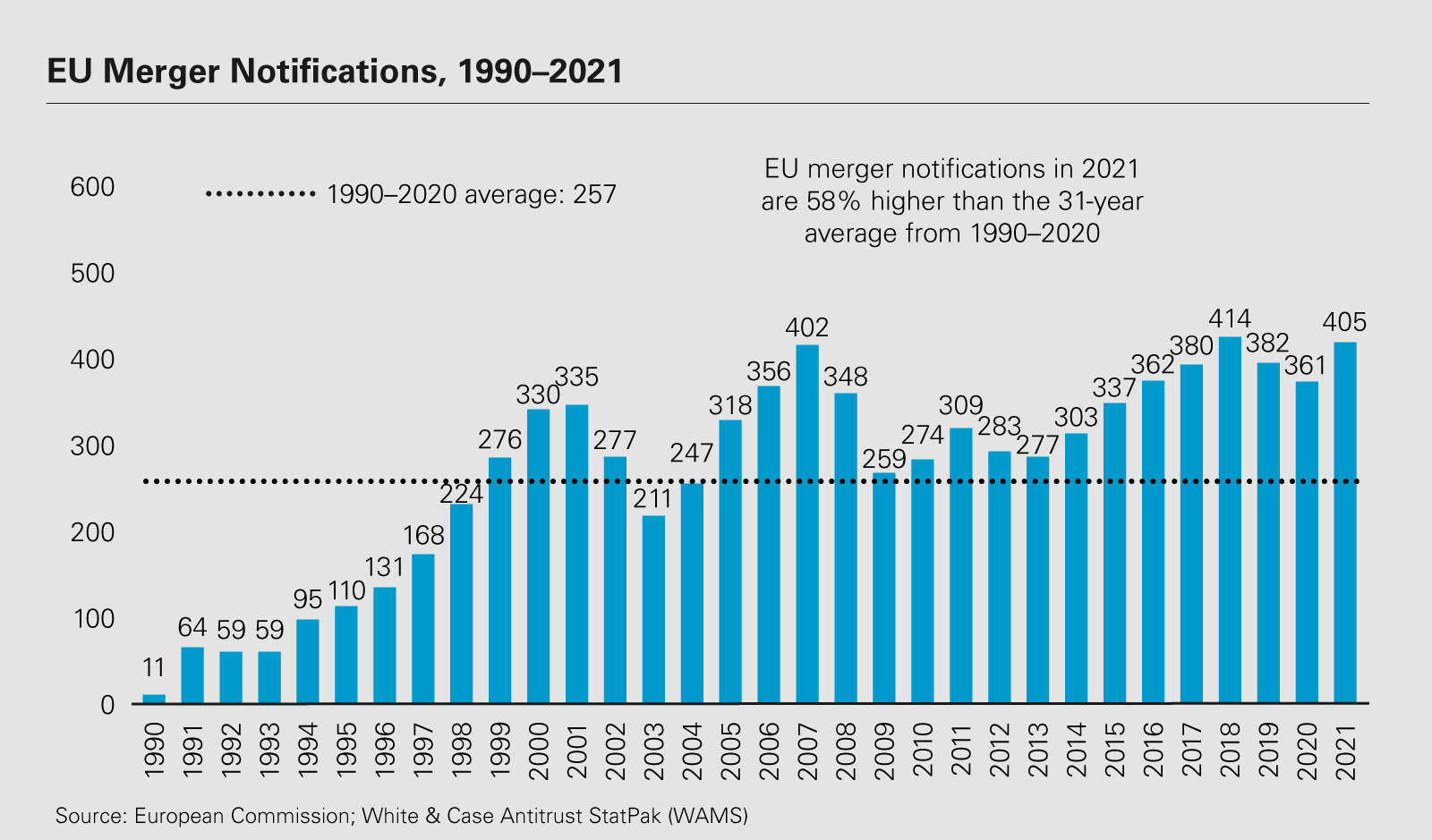 View full image: EU merger notifications, 1990–2021 (PDF)
View full image: EU merger notifications, 1990–2021 (PDF)





